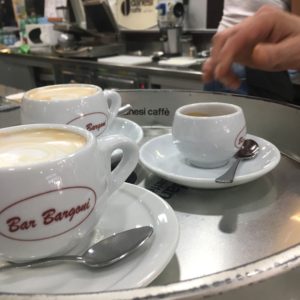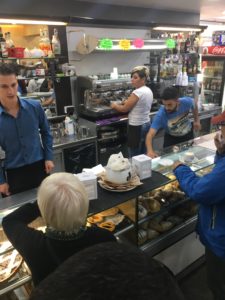Getting coffee in Italy is easy. There are usually coffee spots in every block. Of course, coffee in Italy is different from coffee in the USA. In Italy you never get a bottomless cup of drip coffee as is most common in the states. All the coffee comes out of an espresso machine. The coffees you might order include an espresso, a cappuccino, a latte, a macchiato, and an Americano. I’ll describe these in a moment.
 First though a few notes about getting a coffee. The most common place to stop for a coffee is a small store with a BAR sign. Unlike bars in the USA, Italian BARs are like candy stores with liquor and an espresso machine. (Note – most bars also have a toilette.)
First though a few notes about getting a coffee. The most common place to stop for a coffee is a small store with a BAR sign. Unlike bars in the USA, Italian BARs are like candy stores with liquor and an espresso machine. (Note – most bars also have a toilette.)
When you walk in a bar look around, you might see three things. One – you’ll surely see a counter with a barista ready to serve. Two – there might be chairs and tables. Three – there might be a cash register (cassa) with a cashier.
If there is a cashier, you go to the cashier first, order your drinks, pay, and take the receipt to the barista who will make your drinks. If there is no cashier, you walk up to the bar and order.

Often there is a higher price for your drinks if you plan to sit. If you want to take a table tell the cashier or barista, “per tavolo” – for table – before you order. They will then either charge you accordingly, or ask you to sit for a server to take your order. As far as I’ve seen there is no way to tell about table service, so, I just always ask “Per tavolo?” and do as I’m told.
If there is no cashier, the barista, or table server, will bring the requested drink, and not expect you to pay till the end. If you’re ready to go, and no one is offering a check you can ask “Il conto?” – the check?
Coffee drinks are as follows –
Espresso – (also called “caffe”) shot of dark rich coffee in a tiny cup
Cappuccino – shot of espresso with foamed milk
Caffe Late – shot of espresso with more foamed milk often served in a glass
Macchiato – shot of espresso in a tiny cup “marked” with foamed milk
Americano – an Espresso with extra hot water to approximate a drip coffee (actually better than it sounds)
On a long day of touring and sketching, it is refreshing to stop every few hours and sit with an espresso. An espresso at the counter usually costs about a Euro, so it is the same cost as using public toilettes, and you get a coffee.
Though tipping in Italy is not mandatory, as in the US, it never hurts to leave a bit. “Il resto” – the change – is commonly left with your empty cup. I find that a 5% tip is greeted with gratitude. Anything over 10% is greeted a little suspiciously.